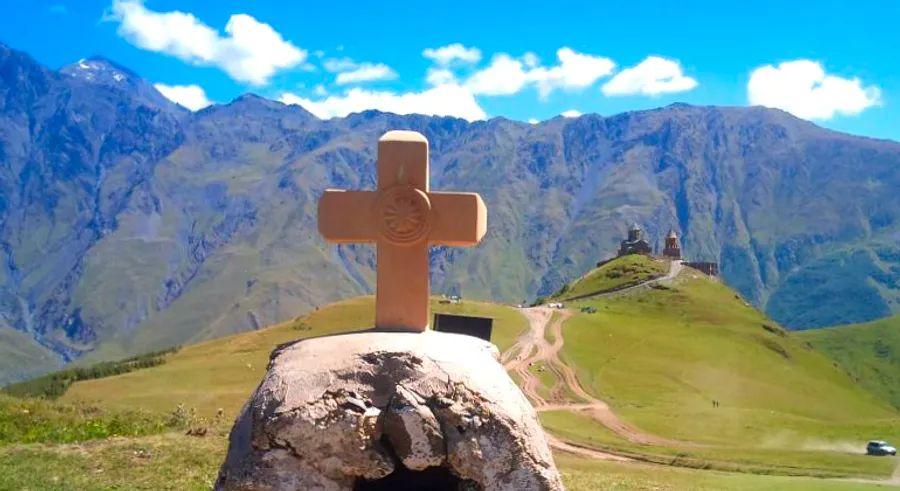9 irresistible reasons to visit Georgia today

Once part of the Soviet Union, Georgia is a land of intrigue and hidden treasures.
Nestled between the towering Caucasus Mountains to the north, the serene Black Sea to the west, and vast deserts to the south, Georgia is bordered by Russia, Azerbaijan, Armenia, and Turkey. This small yet diverse nation is a true crossroads of cultures, offering breathtaking landscapes at every turn.
Not long ago, many travelers might have struggled to pinpoint Georgia on a map (or confused it with the U.S. state), but today it's quickly gaining popularity as a must-visit destination.
Here are nine must-see spots to explore when you visit Georgia:
1. Tbilisi: A vibrant blend of cultures

From the charming, decaying architecture of Old Tbilisi with its hanging balconies, to the Persian-style sulfur baths adorned in shimmering turquoise mosaics, and the striking contrast of art nouveau buildings beside sleek glass skyscrapers, Tbilisi is a city that captivates with its blend of history and modernity.
Nestled along the Mtkvari River and surrounded by mountains on three sides, the capital city of Georgia, Tbilisi, is as stunning as it is strategic.
Archaeologists trace Tbilisi's origins back to the 4th millennium BC. Its pivotal location along the ancient Silk Road transformed it into a melting pot of cultures, a legacy that continues today in the city's vibrant mix of ethnicities and architectural styles.
The thermal baths of Abanotubani follow the Persian tradition, with the added charm of natural sulfur-rich water bubbling up from deep beneath the earth.
Tbilisi derives its name from the Old Georgian word 'tbili,' meaning warm, a nod to the region’s naturally hot sulfur springs.
Venture beyond Abanotubani, and you’ll find Tbilisi’s Old Town, home to ancient Georgian and Armenian churches, mosques, synagogues, and even the ruins of a Zoroastrian fire temple, once the northernmost of its kind.
2. Ushguli: Europe’s highest inhabited village
Perched high in the Caucasus Mountains, at an elevation of 2,200 meters, Ushguli is Europe’s highest village that has been continuously inhabited throughout history.
Nestled at the base of Mount Shkhara, the highest peak in Georgia, Ushguli is renowned for its medieval defensive towers, each uniquely attached to a home.
Located deep within the Svaneti region, Ushguli is famed for its distinct culture, which remained largely isolated from the rest of Georgia for centuries.
While the town of Mestia is rapidly evolving into a resort destination akin to the Swiss Alps, Ushguli’s remote location and limited access have preserved its ancient, untouched atmosphere.
Young men ride horseback at full gallop, racing along dirt paths between crumbling towers, skillfully weaving through herds of livestock in the streets.
Ushguli and Upper Svaneti are designated UNESCO World Heritage Sites for their exceptional cultural and historical significance.
3. The Cradle of Wine
While countries like France, Italy, Greece, and Persia are often linked to the origins of wine, Georgia actually ranks as one of the oldest wine-producing regions in the world.
In 2003, archaeologists discovered evidence that Stone Age civilizations were crafting wine in Georgia as far back as 8,000 years ago.
Since then, wine has remained a fundamental part of Georgia’s cultural heritage and national identity.
Georgia's ancient practice of fermenting grape juice in clay vessels called kvevris has earned a place on UNESCO’s Intangible Cultural Heritage list. With hundreds of native grape varieties, Georgian wine is steadily gaining international acclaim.
While some homemade wines may not be to everyone's taste, Georgia boasts several exceptional vineyards producing top-tier wines.
For a great introduction, try a red wine aged in oak barrels made from the Saperavi grape from Mukuzani in Kakheti, such as those from Teliani Valley, or a crisp white Tsinandali, crafted from a blend of Rkatsteli and Mtvani grapes.
Anthony Bourdain: Make sure Georgia is on your travel list
4. Enigmatic Cave Cities

Georgia is home to some of Europe’s most unique cave cities, and they alone are worth the trip.
The oldest of these cave cities is Uplistsikhe, a site that evokes the surface of the moon. Other fascinating locations include the Davit Gareja monastic complex, carved into Mount Gareja, and Vardzia, a stunning underground city that once sheltered 2,000 monks.
5. Supra: The heart of Georgian culinary tradition
One of the best ways to experience Georgia is through its food. If you haven’t savored a traditional Georgian supra, or feast, then you haven’t truly discovered the essence of the country.
The iconic cheese-filled bread, khachapuri, especially the Adjaran variety, is a must-try. It’s a boat-shaped bread stuffed with rich, gooey sulguni cheese, topped with an egg yolk and a dollop of butter—decadent and utterly irresistible.
Khinkhali are juicy dumplings filled with spiced meat, releasing flavorful stock when bitten, requiring you to slurp out the broth before enjoying. Alongside, you’ll find walnut-dressed salads, fragrant bean stews with cilantro, and mtsvadi, tender marinated meat cooked over an open flame.
Of course, all of this is best enjoyed with a glass of exceptional Georgian wine.
6. Remote Mountain Villages
The remote regions of Khevsureti and Tusheti, nestled in the Caucasus Mountains, are home to ancient medieval villages where small communities still uphold their pagan traditions. The journey to these areas is an adventure in itself, with thrilling, adrenaline-pumping roads.
The crumbling fortress of Mutso and the village of Shatili in Khevsureti seem like scenes straight out of a J.R.R. Tolkien novel. Set against a breathtaking mountain backdrop, they’re so close to the Chechen border that you can spot border guards walking along the ridge.
Tusheti is a collection of mystical mountain communities, resembling a Georgian Shangri-La. Here, you’ll find ancient towers, churches, and villages, surrounded by spectacular landscapes filled with wildflowers and trees with leaves that seem to shimmer golden.
Tusheti boasts an array of hiking trails, and the locals are renowned for their warm, welcoming hospitality high in the mountains.

7. Europe’s Most Surreal Museum
For a glimpse into the life of 'Old Joe,' visit Stalin’s birthplace, Gori, and its unusual Joseph Stalin Museum.
The museum avoids mention of Stalin's purges, except for a small, out-of-the-way backroom that isn’t included in the main tour. The rest showcases countless images of Stalin, including one of him voting for himself.
On display are statues, his death mask, carpets and frescoes bearing his image, his personal green railway carriage, and the museum’s centerpiece: Stalin’s childhood one-room house, preserved exactly as it was.
The museum has faced criticism for being a 'distortion of history' and an example of 'Soviet propaganda.' There were plans to repurpose it into a museum about Russian aggression, but so far, this has only manifested in a small room tucked away by the entrance.
Despite the controversy, it’s worth visiting for its portrayal of Stalin’s self-glorification and propaganda, even though that may not have been its original intent.
8. Stunning and Ancient Churches
Georgia embraced Christianity in 324 AD, and the country is adorned with awe-inspiring churches and cathedrals located in some truly remarkable settings.
From the UNESCO World Heritage sites like Mtskheta’s Svetitskhoveli Cathedral and Kutaisi’s Bagrati Cathedral to the striking hilltop church in Kazbegi, Georgia’s churches are a feast for the eyes.
Kazbegi is also home to one of the most breathtaking marathon routes in the world.
9. The Warmth of Georgian Hospitality
At first, Georgians may seem reserved, but they are incredibly warm and hospitable. To them, a guest is sacred, and they’ll often go out of their way to ensure you’re comfortable. Expect an abundance of food and drink, as their generosity knows no bounds.
As the locals say in Georgia, “Gaumarjos!” (Cheers!).

1

2

3

4

5
Evaluation :
5/5